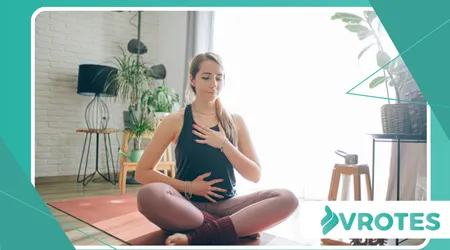Breathing Exercises to Instantly Center Yourself During a Flare-Up

Breathing exercises. Think of your breath as a remote control for your nervous system.
Anúncios
A shallow, rapid breath signals “danger” to your brain, triggering a cascade of stress hormones. Conversely, deep, controlled breaths tell your body it’s safe, activating the parasympathetic nervous system, which promotes rest and digest functions.
This isn’t new-age mysticism; it’s fundamental physiology. When a flare-up hits, whether it’s a wave of panic or a surge of anger, your breath patterns usually mirror that internal chaos.
Taking conscious control of your breathing can interrupt this cycle.
Consider the phenomenon of “physiological sighs.” Research has shown that two quick inhales followed by a long exhale is the fastest way to calm your nervous system.
Anúncios
This natural mechanism, often unconsciously employed, can be intentionally used for rapid centering.
Why Flare-Ups Demand Instant Solutions
Life doesn’t always afford us the luxury of a long meditation session. Sometimes, you’re in a meeting, on public transport, or in a difficult conversation when a wave of intense emotion strikes.
These are the moments when a quick, discreet, and effective technique is invaluable.
The beauty of breathing exercises is their portability. They require no special equipment, no particular location, and can be practiced virtually anywhere.
Their instant impact makes them a perfect tool for immediate relief.
Waiting for an emotional storm to pass on its own can prolong suffering and potentially escalate the situation.
Proactive engagement with your breath empowers you to shift your internal state, rather than being a passive recipient of your emotions.
Mastering the Art of Centering Through Breath
The goal isn’t to suppress emotions, but to regulate the physiological response that often amplifies them.
By shifting your breath, you create a space for clearer thinking and a more measured response. This is about skillful navigation, not avoidance.
Read here: Digital Detox Plan to Improve Sleep and Mental Clarity
Think of a skilled surfer riding a massive wave. They don’t fight the wave; they learn its rhythm, adjust their balance, and flow with its energy.
Similarly, with a flare-up, you acknowledge the emotional wave, but you don’t let it crash over you. You use your breath to maintain your balance.

Simple Breathing Exercises for Immediate Relief
Let’s explore some foundational breathing exercises that offer rapid results
. Practice these when you’re calm, so they become second nature during moments of stress. Consistency builds muscle memory for your nervous system.
4-7-8 Breathing Technique
This technique, popularized by Dr. Andrew Weil, is incredibly effective for relaxation and even sleep. It’s often referred to as a “natural tranquilizer for the nervous system.”
Here’s how to do it:
- Place the tip of your tongue against the ridge of tissue just behind your upper front teeth, and keep it there through the entire exercise.
- Exhale completely through your mouth, making a whoosh sound.1
- Close your mouth and inhale quietly through your nose to a mental count of four.2
- Hold your breath for a count of seven.3
- Exhale completely through your mouth, making a whoosh sound to a count of eight4.
- This is one breath. Inhale again and repeat the cycle three more times for a total of four breaths.
This sequence slows your heart rate and promotes deep relaxation. The “whoosh” sound helps engage your vagus nerve, a key player in the body’s relaxation response.
Read more: How to Identify and Challenge Menopause-Related Negative Thoughts
Box Breathing (Tactical Breathing)
Box breathing, also known as four-square breathing, is a simple yet powerful technique often used by Navy SEALs to maintain focus and calm in high-stress situations.
It provides mental clarity alongside physical relaxation.
Here’s the method:
- Exhale all the air from your lungs.
- Inhale slowly through your nose for a count of four.
- Hold your breath for a count of four.
- Exhale slowly through your mouth for a count of four.
- Hold your breath for a count of four.
Repeat this cycle several times. Visualizing a box as you breathe can enhance the focus.
This consistent rhythm helps regulate your heart rate and settle your mind, pulling you away from the chaotic thoughts of a flare-up.

Diaphragmatic Breathing (Belly Breathing)
Many people breathe shallowly, using only their chest. Diaphragmatic breathing engages the diaphragm, leading to deeper, more efficient breaths that calm the nervous system.
How to practice:
- Lie on your back with your knees bent, or sit upright in a comfortable chair.
- Place one hand on your chest and the other on your belly, just below your rib cage.
- Inhale slowly through your nose, feeling your belly rise as air fills your lungs. Your chest should remain relatively still.
- Exhale slowly through pursed lips, feeling your belly gently fall.
This exercise ensures you’re getting full, deep breaths, which significantly impacts your physiological state. It’s the foundation for many other breathing exercises.
++ Menopause and Memory: Foods That Support Cognitive Function
Integrating Breathwork into Daily Life
The true power of these techniques lies in their consistent application. Don’t wait for a crisis to practice. Incorporate short breathwork sessions into your daily routine. Even five minutes a day can build resilience.
One common mistake is trying these techniques only when you’re already overwhelmed.
Think of it like a fire drill: you practice when there’s no fire, so you know exactly what to do when one ignites. Similarly, regular practice makes these techniques readily accessible during moments of acute stress.
Consider the increasing recognition of mindfulness and breathwork in corporate settings.
Companies are investing in these programs, recognizing that employee well-being directly impacts productivity and retention.
A 2023 study published in JAMA Network Open found that structured breathing practices significantly reduced perceived stress and improved mood in participants over an eight-week period.
This isn’t just anecdotal evidence; it’s a testament to the tangible benefits of conscious breath.
When to Use These Techniques
These methods are designed for immediate impact during a flare-up. Here are some scenarios where they prove invaluable:
| Scenario | Type of Flare-Up | Recommended Technique |
| Public Speaking Anxiety | Performance anxiety, fear | 4-7-8 Breathing |
| Argument with a Loved One | Anger, frustration | Box Breathing |
| Sudden Panic Attack | Intense fear, physical symptoms | Diaphragmatic Breathing |
| Overwhelm at Work | Stress, mental fatigue | Box Breathing |
| Before a Difficult Conversation | Nervousness, apprehension | 4-7-8 Breathing |
Beyond the Immediate: Long-Term Benefits
While our focus is on instant centering, the consistent practice of breathing exercises yields profound long-term benefits.
Reduced chronic stress, improved sleep quality, enhanced emotional regulation, and even better cardiovascular health are all potential outcomes.
It’s about building a robust internal toolkit. When you consistently practice, you’re not just reacting to stress; you’re proactively strengthening your capacity to handle it.
This creates a ripple effect, positively influencing all areas of your life.
For example, imagine you have a tendency to overthink before making big decisions, leading to analysis paralysis.
By incorporating breathwork, you might find yourself more grounded, able to assess options with greater clarity, and less prone to getting lost in anxious spirals.
This small shift can lead to better decision-making and reduced stress in the long run.
Concluding Thoughts on Inner Calm
The ability to instantly center yourself during a flare-up is a powerful skill, and breath is your most accessible tool.
These breathing exercises are not a magic bullet that makes problems disappear, but they are a potent means to shift your internal state, allowing you to approach challenges with greater clarity and calm.
They are a testament to the profound connection between mind and body, offering immediate, tangible relief. Why not give yourself the gift of this vital self-care practice? It’s always within your reach.
Frequently Asked Questions
Here are some common questions about these techniques:
1. How long should I practice these techniques to see results?
You might feel the effects immediately, but consistency is key. Try to practice for 5-10 minutes daily to build resilience and make the techniques more effective when you need them most.
2. Can I use these techniques for any type of “flare-up”?
Yes, they’re versatile and can help manage a variety of emotional and physical responses, from anxiety and anger to pain or stress. The goal is always to calm your nervous system.
3. Are there any contraindications for breathing exercises?
Generally, they’re safe. However, if you have severe respiratory or cardiac conditions, consult a doctor before starting any new intense breathing practice. Begin slowly and listen to your body.
4. Do I need a quiet place to practice?
Ideally, a peaceful location helps with concentration. But the beauty of these techniques is that they can be practiced anywhere—at work, on public transport, or before a stressful event.
5. How do I know if I’m doing it correctly?
The key is to feel your breathing slow down and your body relax. Practice leads to improvement. Don’t worry about being perfect; just focus on intentionally guiding your breath.
